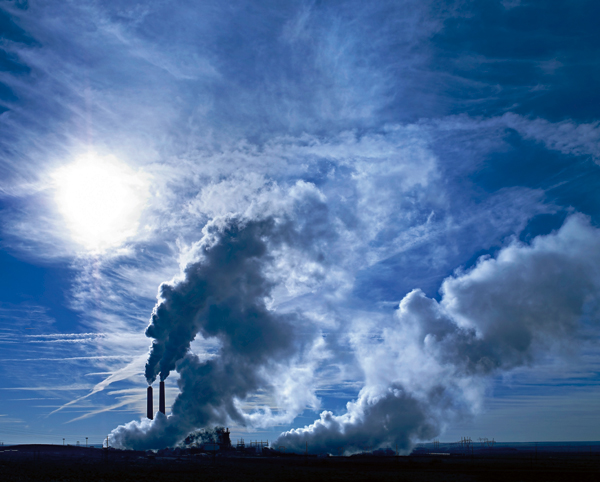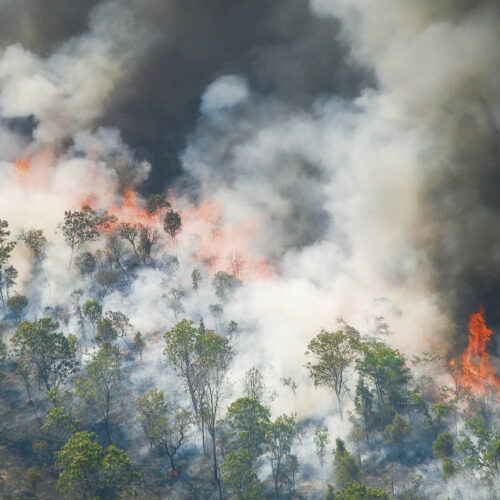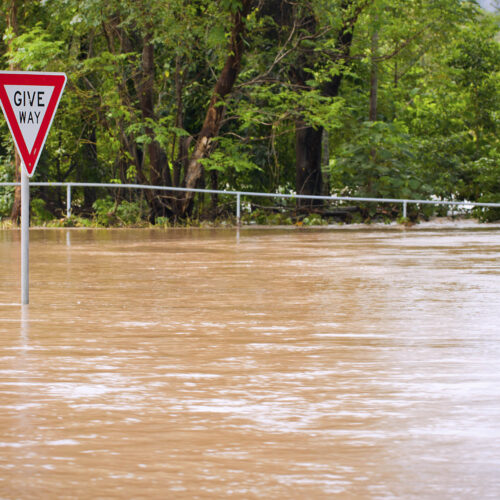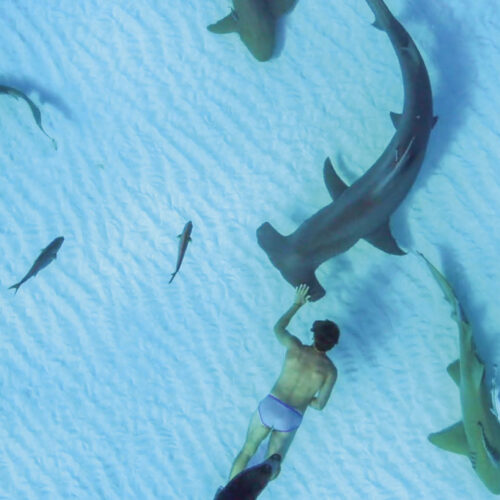As the Earth Breathes
2012-01-04T03:47:31+11:00
Human-created global warming first appeared on our radar more than a century ago, and scientists have been charting its ominous development ever since. Environmental author and activist ALBERT BATES reflects on the unfolding history of global warming and humanity’s response
Today we are talking about four degrees, perhaps, in the next half-century. The temperature change in a single day is usually several degrees, even at the equator, so the thought of a four-degree change is not particularly frightening for most people. But to change the global average by even one degree requires heating an enormous volume of ocean water, an enormous volume of atmosphere, and an enormous volume of land surface.
We are only about three degrees warmer today, on a global average, than we were 20,000 years ago when there was a thick mantle of ice over Canada and Northern Europe. Four degrees more, which is where we may find ourselves in a few decades, is a pretty big deal. So how did we get to this point?
Seeing the light
Forty or so years later, in 1896, Swedish chemist Svante Arrhenius warned that industrial-age coal burning would magnify the natural greenhouse effect. Thirty-seven years more would pass before carbon emissions from fossil fuel burning reached one billion metric tonnes per year, and human population passed the two-billion mark.
Keeling also discovered that carbon dioxide levels changed according to the seasons – decreasing as plants used it as they surged in the summer, and increasing as they shed foliage and decayed in the cooler seasons. Gillis writes: “He had discovered that the earth itself was breathing.” In the late 1950s, around the time Keeling made his first climb up the slopes of the Mauna Loa volcano to start CO2 measurements, the human population exceeded three billion.
Alarm bells
Perhaps even more startling to those buried in the current debate on the science of global warming, is the 1965 report of the US President’s Science Advisory Committee. It warned then President Lyndon B. Johnson that the Greenhouse effect was a matter of “real concern”. With estimated recoverable fossil fuel reserves sufficient to triple atmospheric carbon dioxide, the committee wrote in its report that “man is unwittingly conducting a vast geophysical experiment”. The report also concluded that by the year 2000, emissions could be sufficient to cause “measurable and perhaps marked” climate change. Johnson issued a Special Message to the Congress, warning: “This generation has altered the composition of the atmosphere on a global scale.” It was in 1975 that climatologist Wallace Broecker coined the term “global warming” and began warning that sudden climate shifts were not Historically unprecedented. Historians such as Charles Mann and Jared Diamond described how the sands of time are littered with great civilisations brought low by climate change.
The decade that followed carried a spate of in-depth inquiries by scientific bodies, government committees, and the United Nations. A report that reached then US President Jimmy Carter’s desk was so alarming that Carter asked his National Academy of Sciences for a second opinion. That investigation confirmed, in 1979, that by the year 2035, mean global temperature could rise 2-3°C, and polar warming as much as 10-12°C. By 1987, 30 years after Keeling first started his CO2 measurements, and nearly a century after Arrhenius’s calculations, the human population had reached five billion.
United Nations
In 1992, the United Nations created the UN Framework Convention on Climate Change. Its objective was the “stabilisation of greenhouse gas concentrations in the atmosphere at a level that would prevent dangerous anthropogenic interference with the climate system”. Three years later, scientists described how “dangerous anthropogenic interference” with the climate system was already occurring. Meanwhile, virtually no progress was made on any of the goals that had been set for emissions reductions. Business as usual had taken control, and the denial machine had slipped into overdrive. In 1999, human population reached the six billion mark.
Tipping point
In 2001, the Intergovernmental Panel on Climate Change (IPCC) issued even stronger warnings, based on new evidence of dangerous anthropogenic interference. In response, the UN enacted the Kyoto Protocol to require greenhouse emission reductions, with the target of returning the world to its 1990 emissions level by 2012. In hindsight, Kyoto was regarded as a failure, unable to alter the trajectory of fossil fuel use, or anticipate the admission of new members to the greenhouse gas-producing family, such as China, India, Indonesia and Brazil. World population was still exploding, and people in the West seemed to want an even larger house, a two-car garage, air-conditioning and the latest consumer appliances. Could lower expectations be demanded of the rising middle classes in China or Brazil? In 2006, former US Vice-President Al Gore released the documentary
Another report, released in 2009 by the Global Humanitarian Forum, found that 300,000 deaths per year were already attributable to climate-change-related weather, food shortages and disease. That figure could be called our baseline – or background count – of the 20th-century-long experience of a temperature change of less than 1°C. Despite all the work done by the UN’s Framework Convention on Climate Change up to Copenhagen in 2009, and the most recent meeting of 194 nations in Cancún, Mexico, in November last year, there is still no binding treaty urbing greenhouse gas emissions. Many scientists, such as James Lovelock and Paul Erhlich, are now wondering if humanity is up to the challenge.
Emotional backlash
There is a strong counter-current to all of these reports and warnings, and it likely arises from the deepest recesses of the human psyche. Long-term climate change is a phenomenon not easily detected by personal experience, in the way weather is. Even risk of extreme events like floods and droughts tend to be underestimated unless they are in recent experience. If we view the problem as one of winners and losers, and we are not personally affected, we tend to associate ourselves with the winners and assume the losers will be taken care of by governments and social agencies. Constraints on our patterns of consumption – income, awareness, social conscience – vary considerably between cultures and within populations, but we are social animals. We seek the approval of our peers. Having the will to go against the flow may incur considerable social pressure. Seizing on these feelings, some governments, corporations and individuals with vested interests in maintaining fossil fuel production or political hegemony based on the control of oil and coal, or even just a status quo that has been very kind to them, have spent considerable energy and money influencing public opinion and casting doubt on the science of climate change(2). For instance, a 2010 Greenpeace report accused the previously little-known industrial conglomerate, Koch Industries, of contributing $US24.9 million to “climate denial” organisations between 2005 and 2008. Koch said Greenpeace had “mischaracterised” its efforts. “We’ve strived to encourage an intellectually honest debate on the scientific basis for claims of harm from greenhouse gases,” a Koch spokesperson said.In addition, an unwillingness to jeopardise continued economic growth, whether in developed industrial nations or developing countries, remains a major stumbling block to positive change.
A positive sign
Luckily, not everyone has their armour on and extreme weather events are beginning to put chinks in even the toughest. Also, market forces are swiftly, in some cases, moving behind renewable energy and energy efficiency measures, while the United Nations is doing good work to stop forest destruction.Hidden within the Cancún agreements are some remarkable passages on what we will need to do as a species to abate catastrophic climate change. Among them is REDD –Reduced Emissions from Degradation and Deforestation – which urges nations to find effective ways to reduce the human pressure on forests and reverse the drivers of land degradation. The REDD forest carbon-protection scheme is a template for what may come: a soils carbon-protection and restoration scheme involving a shift to organic gardening and farming, as well as initiatives such as broad-scale municipal composting. Despite our history of inaction and our increasingly desperate situation, the power and the means remains primarily with people, working locally, to restrain the worst from coming into being.
~~~~~~~~~~~~
Albert Bates is a founder of the Global Ecovillage Network (GEN) and author of 14 books on energy, environment and history, including Climate in Crisis (1990) and The Post Petroleum Survival Guide (2006). He shared the Right Livelihood Award in 1980 for his work on the steering committee of Plenty, working to preserve the culture of indigenous peoples in the Americas. His latest book is The Biochar Solution: Carbon Farming and Climate Change An Inconvenient Truth, which had a dramatic effect in raising public awareness and acceptance of climate change worldwide. In 2007, carbon emissions from fossil fuels reached eight billion metric tonnes per year, with a comparable amount being generated by animals raised for that it was now certain that humanity’s emissions of greenhouse gases were responsible for climate change. On May 19, 2009, Woods Hole Research Laboratory and the Massachusetts Institute of Technology released a study of the best climate data that was currently available. The conclusion: the effects of climate change were twice as severe as estimated just six years previously, and the probable median of surface warming by 2100 is now 5.2°C, compared to a finding of 2.4°C in 2003. Moreover, the study rated the possibility of warming to 7.4°C by the year 2100 (and still accelerating thereafter) at 90 per cent. In most countries, government and corporate llingness to bring about reductions was both feeble and failing. slaughter and from forest clearing. The IPCC’s Fourth Assessment Report concluded, almost anti-climactically, Collecting evidence In the 1930s, British engineer Guy Callendar compiled empirical evidence that the heat effect was already discernible. By the 1950s, measuring equipment had improved to the point where Canadian physicist Gilbert Plass could detail the infrared absorption of various gases; American scientists Roger Revelle and Hans Suess could show that seawater was incapable of absorbing the rate of man-made CO2 entering the atmosphere; and American scientist Charles David Keeling could produce annual records of rising atmospheric carbon levels from observatory instruments in Hawaii (at the Mauna Loa volcano) and Antarctica. In an article in the New York Times last year(1), Justin Gillis said Keeling’s discoveries “transformed the scientific understanding of humanity’s relationship with the earth”. Indeed his discovery in the 1950s that the background level for carbon dioxide was about 310 parts per million, and rising, lead to government backing for his research.In 1824, while working in a Paris laboratory on observations of the earth, Joseph Fourier described the greenhouse effect for the first time: “The temperature [of the earth] can be augmented by the interposition of the atmosphere, because heat in the state of light finds less resistance in penetrating the air, than in re-passing into the air when converted into non-luminous heat.” It was a remarkably prescient discovery, given the science of the time. We know now that “heat in the state of light” arrives as high-energy shortwave radiation, able to penetrate atmospheric clouds (or glass windows), and is transformed by contact into infrared, or what Fourier called “chaleur obscure” (non-luminous heat). This then attempts to depart as low-energy long-wave radiation, only to bounce back if obstructed (such as by airborne soot or clouds of greenhouse gases). Fourier appreciated the infrared effect from the work of a contemporary, William Herschel, and was quick to realise that how you warm the earth is the same as how you warm a greenhouse. Then in the 1850s, the Irish physicist John Tyndall demonstrated that water vapour is one of the important components of the earth’s greenhouse shield. “This aqueous vapour is a blanket more necessary to the vegetable life of England than clothing is to man,” Tyndall remarked.Scientists who study climate have known for ore than a century that a doubling of CO2 in the atmosphere could bring a 5°C rise in global temperature. However, in the 1970s most people who studied in this field said temperatures were rising very slowly, only a half-degree per century, and that we had time to do something about it. They sure got that wrong.
References
1 –A Scientist, His Work and a Climate Reckoning, by Justin Gillis, New York Times (21/12/2010).
2 – More on this topic in James Hoggan’s book,
3 – You can read articles by George Monbiot in the Guardian newspaper or on his website: www.monbiot. com/2009/11/02/death-denial/
A Scientist, His Work and a Climate Reckoning, by Justin Gillis,New York Times (21/12/2010).Climate Cover-Up: The Crusade to Deny Global Warming.






